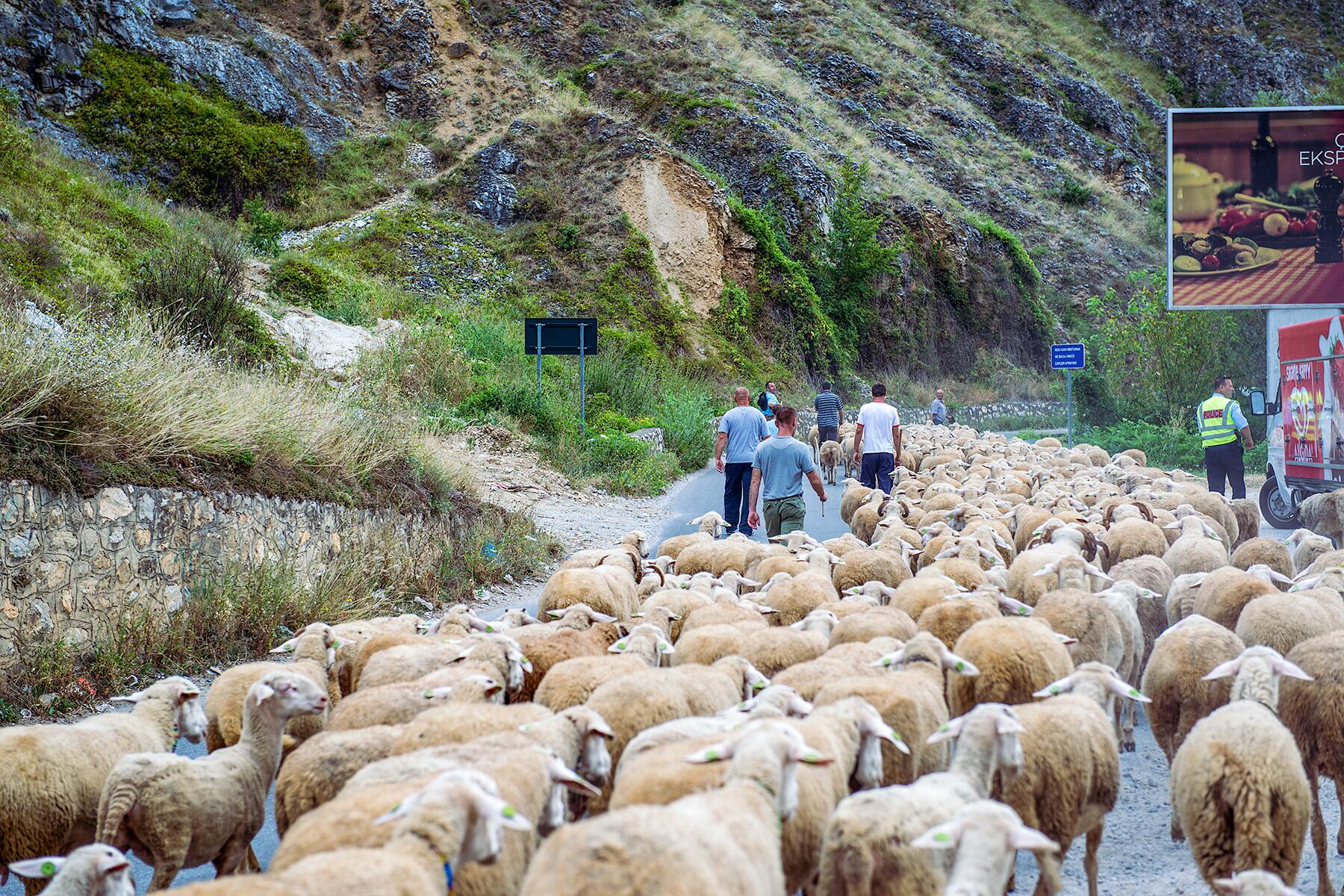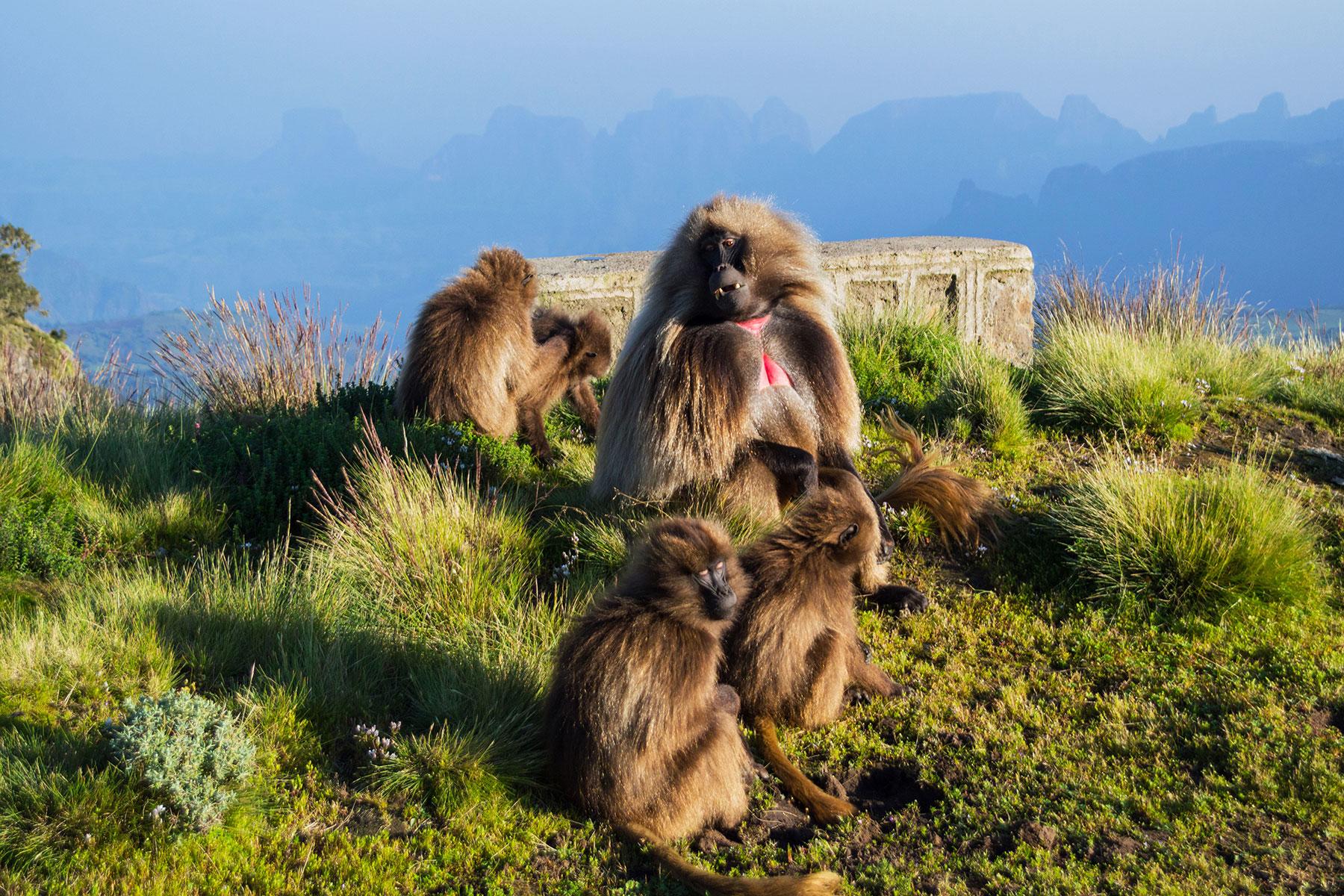- ⁄
- Travel News
- ⁄
- Family •
- News •
- Outdoors
This vast African country is home to some of the world’s rarest–and weirdest–wildlife.
Ethiopia’s wildlife is as eclectic and enchanting as the landscape. Black-maned lions roam through fairytale forests under the shelter of giant fig trees draped with moss and lichen. Endangered wolves slink between rocks on mountain plateaus, hunting giant mole-rats. And, on the cliff-top meadows of the Simien Mountains, huge troops of endemic gelada monkeys graze, preen, and play. From the awe-inspiring to the downright odd, here are some of the animals that can be spotted on a visit to Ethiopia.
Ethiopian Wolf
More than 4,000 meters above sea level, the Sanetti Plateau in Bale Mountains National Park is an ear-popping experience. It’s also an eye-popping one, especially if you’re lucky enough to catch a glimpse of the world’s rarest wolf. Spotting the copper-coated creatures, which slink behind rocks and alpine shrubs like particularly elegant foxes, isn’t actually too tricky in this broad, lunar-like landscape. There are fewer than 500 Ethiopian wolves remaining in the wild, with the majority living on this plateau.
Black-Maned Lion
With golden manes edged in jet black, Ethiopian or Abyssinian lions are even more striking than your typical king of the jungle. So rare they were once feared extinct, the lions have recently been spotted roaming the Harenna Forest in Bale Mountains National Park. The animals are associated with the Rastafari religion, formed in the 1930s following Haile Selassie’s coronation as king of Ethiopia. Followers believe the emperor was a god, naming him the “Conquering Lion of Judah” and wearing dreadlocks to mirror the lions’ black manes.
Recommended Fodor’s Video
Spotted Hyena
These much-maligned scavengers can be found across the country. But in Harar–a hilltop, walled city in the east–they are legendary. Farmers feed the hyenas daily, a tradition that started in the 1960s as a way to prevent them attacking livestock. This ritual, which involves the so-called “hyena men” hand-feeding the animals with scraps of raw meat, has become a popular tourist attraction.
Olive Baboon
Named for their brownish-green fur, these square-headed baboons can adapt to environments from grasslands to forests–partly because they will eat almost anything.
It’s not uncommon for dozens of these baboons to halt traffic. Hanging out in troops of up to 50, they aren’t intimidated by humans. They take their sweet time, sauntering along the road with bums in the air and babies clinging to their backs.
Colobus Monkey
There’s something inherently wise about these monkeys found in Bale Mountains National Park. Their solemn, sage-like faces peer from behind snow-white beards, capped with what looks like a black fez. The monochrome mammals can be spotted swinging through the branches, aided by their long tails and a cape of silky fur.
Don’t be surprised if they stare–and yes, they probably are judging you.
Gelada
Once believed to be particularly gentle baboons, these grass-eating primates are actually monkeys. Their nickname, “bleeding heart baboons,” has stuck thanks to the striking crimson crests on their chests.
Found only in the Simien Mountains, geladas gather in huge groups during the daytime for increased protection against predators such as hyenas. The monkeys are a wildlife lover’s dream–you can sit right among them, quietly observing as they groom, graze, preen and play. Visitors have been known to meditate or practice yoga while hanging out with the geladas, whose males sport huge blond manes. At dusk, the monkeys scramble down from the meadows to sleep in cliffside caves.
Ruspoli’s Turaco
Endemic to the forests of southern Ethiopia, the rare and enchantingly odd Ruspoli’s turaco boasts bold plumage in navy, scarlet, and pea green, offset by a peroxide blonde “mohawk.” Throw in red-rimmed eyes and its punk-rock look is complete.
The beautifully bizarre bird was named after Italian explorer Prince Ruspoli, who first discovered the species in the late 1800s.
INSIDER TIPDespite its striking looks, the Ruspoli’s turaco is surprisingly elusive. An organized birdwatching trip with local experts offers the best chance of spotting one.
Golden Eagle
Those who head to the Bale Mountains to track Ethiopian wolves might spy huge, winged shadows rippling over the rocks and heather. The area is home to a small, isolated population of magnificent golden eagles, which nest in the cliffs and occasionally soar across the Sanetti Plateau, scouring for prey.
Blue-Breasted Bee Eater
With feathers that shimmer in shades of emerald, sapphire, and gold, these tiny birds are like winged jewel boxes. Their colorful plumage makes them easy to spot against the muddy edges of watering holes and swamps, where they can often be found fluttering about. You can also find these beauties in forested areas around the edges of the Rift Valley lakes.
Bale Mountains Vervet
These elusive, endemic monkeys tend to eat their homes. They live in bamboo forests in the Bale Mountains, with a diet restricted to the plants’ leaves and stems.
Relatively little is known about the primates, which are classed as “vulnerable,” though it is possible to spot them with a little luck and a lot of patience. And there’s no mistaking them for another species–their fluffy white “beards” and voluminous caps of chestnut hair make these guys pretty distinctive.
Menelik's Bushbuck
Called dukulas in Amharic (Ethiopia’s most widely spoken language), Menelik’s bushbucks are particularly shy and elusive members of the antelope family. If they hear you coming, they’ll quickly flee. Tread daintily, though, and you might get a good look, especially in forested areas in the highlands. They have white stripes and delicate dots around their bellies, with the females’ copper coats distinguishing them from their similar but larger relatives, mountain nyalas.
Walia Ibex
Pack some sturdy walking boots if you want to see these endangered members of the goat family. Walia ibexes are only found in the northern Ethiopian highlands, including the jagged cliffs of the Simien Mountains, and seeking them out requires at least a day’s trek. It’s worth the walk, though. These gorgeous, coffee-colored animals, whose enormous horns arch backward as if windswept, are endangered due to poaching and loss of habitat.
Mountain Nyala
Also known as balboks, these endangered antelopes are endemic to the Bale Mountains. Elegant and poised, they have taupe coats with distinctive white stripes across their noses, necks, and chests, while the males’ antlers curve in the shape of a corset.
INSIDER TIPThe woodland by the entrance to Bale Mountains National Park is the best place to observe mountain nyalas. Enquire at the registration office to arrange a guided walk.
Somali Wild Ass
Donkeys are everywhere in Ethiopia, used to carry crops and pull carts filled with people. In fact, at around seven million, Ethiopia’s donkey population is the world’s largest. The Somali wild ass, found in the northern deserts of the Afar region, is at the opposite end of the scale. There are an estimated 700 remaining in the wild, putting them on the critically-endangered list. They’re paler grey in color than their equine cousins and have stripy legs, like a cross between a donkey and a zebra.
Yellow-Fronted Parrot
It’s actually this parrot’s face that’s yellow, offset by vibrant green plumage and orange eyes ringed in grey. Either way, these rare birds are as pretty as they come.
Little is known about the species, but it’s thought the 10-inch-tall parrots live only around Lake Tana in the Amhara region, where their shrill squawks can be heard echoing through the forest.
Bearded Vulture
Most vultures love nothing more than a rotting carcass, flocking to pick at the meat. Bearded vultures, or lammergeier, are partial to dead animals too–but they’re only interested in the skeleton.
These enormous (and frankly, terrifying) birds are unique in feeding almost exclusively on bones, dropping them from a height to break them and reveal the marrow. Nesting in the cliffs of the Ethiopian highlands, the huge birds–among the world’s largest with an average wingspan of nine feet–cut a dramatic figure.
Honey Badger
Never mess with a honey badger. Sweet as they may sound, these bouncy beasts are tenacious and can be pretty ferocious. Just ask the beekeepers of the Harenna Forest, who place their hand-carved bamboo hives in tree canopies–partly to make it trickier for the badgers to reach them and snaffle the honey.
INSIDER TIPVisit in early December to witness the bizarre honey harvest, where beekeepers climb barefoot to retrieve sticky nectar from their treetop hives. Tours can be arranged through Bale Mountain Lodge–chalet-style accommodation in the heart of the Harenna Forest.
Giant Mole-Rat
The creatures are also known as “lunch” if you happen to be an Ethiopian wolf. An abundance of these fat, juicy and (apparently) tasty rodents is one of the main reasons the world’s rarest canids roam the Sanetti Plateau. The wolves are actually easier to spot, with copper coats that pop against the shrubby landscape. Giant mole-rats, by contrast, blend seamlessly with the soil. They spend most of their lives tunneling underground, occasionally popping their huge heads above the soil to squint through beady eyes.
White-Cheeked Turaco
With moss-green plumage and eyes circled in tangerine, these bizarre birds are only found in Ethiopia and neighboring Eritrea. They’re related to Prince Ruspoli’s turaco, though are not nearly so rare or elusive. They become especially spectacular when they take to the air, revealing vibrant scarlet wings. Find them fluttering around the edges of forests and in the Ethiopian highlands.
Swayne’s Hartebeest
Why the long face? These antelopes were born that way. Named after the British officer who discovered this species, the Swayne’s hartebeest is also endangered. Once hunted to near-extinction, their numbers are still low. Find the chestnut brown, droopy-faced animals in Nechisar National Park, home to a protected population, and near the shores of the Rift Valley’s lakes.
Flamingo
Leggy, pink flamingos are the supermodels of the bird world. En masse, they are truly spectacular. Not so elusive after all: tens of thousands wade around the shores of Lake Chitu in the Rift Valley, regularly flapping over to nearby Lake Shalla–creating a pretty pink layer above the water, like rose-petal confetti scattered from the heavens.




